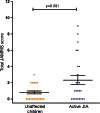Contrast-enhanced MRI of the knee in children unaffected by clinical arthritis compared to clinically active juvenile idiopathic arthritis patients
- PMID: 26233246
- PMCID: PMC4778146
- DOI: 10.1007/s00330-015-3912-z
Contrast-enhanced MRI of the knee in children unaffected by clinical arthritis compared to clinically active juvenile idiopathic arthritis patients
Abstract
Objectives: To evaluate enhancing synovial thickness upon contrast-enhanced magnetic resonance imaging (MRI) of the knee in children unaffected by clinical arthritis compared with clinically active juvenile idiopathic arthritis (JIA) patients. A secondary objective was optimization of the scoring method based on maximizing differences on MRI between these groups.
Methods: Twenty-five children without history of joint complaints nor any clinical signs of joint inflammation were age/sex-matched with 25 clinically active JIA patients with arthritis of at least one knee. Two trained radiologists, blinded for clinical status, independently evaluated location and extent of enhancing synovial thickness with the validated Juvenile Arthritis MRI Scoring system (JAMRIS) on contrast-enhanced axial fat-saturated T1-weighted MRI of the knee.
Results: Enhancing synovium (≥2 mm) was present in 13 (52 %) unaffected children. Using the total JAMRIS score for synovial thickening, no significant difference was found between unaffected children and active JIA patients (p = 0.091). Additional weighting of synovial thickening at the JIA-specific locations enabled more sensitive discrimination (p = 0.011).
Conclusions: Mild synovial thickening is commonly present in the knee of children unaffected by clinical arthritis. The infrapatellar and cruciate ligament synovial involvement were specific for JIA, which-in a revised JAMRIS-increases the ability to discriminate between JIA and unaffected children.
Key points: • Synovial inflammation is the primary disease feature in juvenile idiopathic arthritis (JIA). • Appearance of the synovium on contrast-enhanced MRI in unaffected children is unknown. • Validation of existing scoring methods requires comparison between JIA and unaffected children. • Mild enhancing synovial thickening was detected in half of the unaffected children. • Location-weighting for JIA-specific locations increased discriminative value of the scoring methods (p = 0.011).
Keywords: Control group; Juvenile idiopathic arthritis; Knee; Magnetic resonance imaging; Synovium.
Figures





Similar articles
-
Juvenile idiopathic arthritis: magnetic resonance imaging of the clinically unaffected knee.Pediatr Radiol. 2018 Mar;48(3):333-340. doi: 10.1007/s00247-017-4059-7. Epub 2018 Jan 6. Pediatr Radiol. 2018. PMID: 29307035 Free PMC article.
-
Normal MRI findings of the knee in patients with clinically active juvenile idiopathic arthritis.Eur J Radiol. 2018 May;102:36-40. doi: 10.1016/j.ejrad.2018.02.027. Epub 2018 Mar 6. Eur J Radiol. 2018. PMID: 29685542
-
Contrast-enhanced MRI compared with the physical examination in the evaluation of disease activity in juvenile idiopathic arthritis.Eur Radiol. 2014 Feb;24(2):327-34. doi: 10.1007/s00330-013-3036-2. Epub 2013 Oct 8. Eur Radiol. 2014. PMID: 24101236
-
Imaging of the knee in juvenile idiopathic arthritis.Pediatr Radiol. 2018 Jun;48(6):818-827. doi: 10.1007/s00247-017-4015-6. Epub 2018 May 8. Pediatr Radiol. 2018. PMID: 29766248 Free PMC article. Review.
-
Current Status of Efforts on Standardizing Magnetic Resonance Imaging of Juvenile Idiopathic Arthritis: Report from the OMERACT MRI in JIA Working Group and Health-e-Child.J Rheumatol. 2016 Jan;43(1):239-44. doi: 10.3899/jrheum.141276. Epub 2015 May 15. J Rheumatol. 2016. PMID: 25979714 Review.
Cited by
-
Comparison of contrast-enhanced MRI features of the (teno)synovium in the wrist of patients with juvenile idiopathic arthritis and pediatric controls.Rheumatol Int. 2022 Jul;42(7):1257-1264. doi: 10.1007/s00296-021-05041-9. Epub 2021 Nov 22. Rheumatol Int. 2022. PMID: 34811568 Free PMC article.
-
MRI Findings in Hip in Juvenile Idiopathic Arthritis.J Clin Med. 2021 Nov 11;10(22):5252. doi: 10.3390/jcm10225252. J Clin Med. 2021. PMID: 34830537 Free PMC article.
-
Juvenile idiopathic arthritis: magnetic resonance imaging of the clinically unaffected knee.Pediatr Radiol. 2018 Mar;48(3):333-340. doi: 10.1007/s00247-017-4059-7. Epub 2018 Jan 6. Pediatr Radiol. 2018. PMID: 29307035 Free PMC article.
-
Diffusion-weighted imaging for assessment of synovial inflammation in juvenile idiopathic arthritis: a promising imaging biomarker as an alternative to gadolinium-based contrast agents.Eur Radiol. 2017 Nov;27(11):4889-4899. doi: 10.1007/s00330-017-4876-y. Epub 2017 Jun 12. Eur Radiol. 2017. PMID: 28608162 Free PMC article.
-
Intravoxel incoherent motion magnetic resonance imaging of the knee joint in children with juvenile idiopathic arthritis.Pediatr Radiol. 2017 May;47(6):681-690. doi: 10.1007/s00247-017-3800-6. Epub 2017 Mar 10. Pediatr Radiol. 2017. PMID: 28283723
References
-
- Wallace CA, Giannini EH, Spalding SJ, et al. Clinically inactive disease in a cohort of children with new-onset polyarticular juvenile idiopathic arthritis treated with early aggressive therapy: time to achievement, total duration, and predictors. J Rheumatol. 2014;41:1163–1170. doi: 10.3899/jrheum.131503. - DOI - PubMed
Publication types
MeSH terms
Substances
LinkOut - more resources
Full Text Sources
Other Literature Sources
Medical

